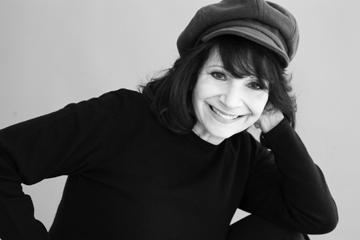
Those who think they know Norman Rockwell from his years of illustrating Saturday Evening Post covers don’t know the whole story. At a very early age, Rockwell learned, “Don’t show life as it really is, but how folks want it to be.” And that sums up his life as an artist.
Former Kansas Citian Eileen Bluestone Sherman became fascinated with Rockwell after a family trip to Vermont back in the early 1990s where she discovered a small Norman Rockwell gallery. The people there were volunteers who had been Rockwell’s neighbors and former models.
Then after reading an autobiography titled “My Adventures as an Illustrator, as Told to My Son Thomas Rockwell” she says she couldn’t help but see the lyricism in it.
“The lines of the book are just popping into my head as great song titles,” Bluestone Sherman says. “It was written in such great rhythm and had such a great vibe to it and I’m thinking my goodness this could be a great musical.”
This is how the musical “Rockwell” was born, which debuted in 1992 at the Southern Vermont Art Center in Manchester, Vermont. Since then it has gone through a lot of different stages of development with different directors putting their own touch on it, and sitting on the shelf for many years.
The music was performed in 2002 as an equity reading featuring all-Broadway stars. In 2011, Bluestone Sherman was ready to take another look at it because people kept asking her what happened to the Rockwell project.
She produced a CD of the music from the show, again utilizing big-name Broadway stars, calling it “Perfect Picture.” The producer at Lincoln Center in New York City expressed an interest in doing something with the Rockwell musical.
So she reprised it as a concert at Lincoln Center on Oct. 31, 2016. About that same time, she received a call from Meg Adler, vice president of fund development of NCJW-KC, who had read about the musical on Bluestone Sherman’s website. Adler says she asked if NCJW-KC could use it for their fundraiser.
“She said of course because she’s Eileen and we’re Kansas City,” says Adler. “She’s given us a lot of leeway and license to change things, so it should be pretty awesome. This is a one-shot, one-night actual play with choreography and we’re going to do it the way it was designed to be done. It is an hour-and-a-half extravaganza.”
Bluestone Sherman says Adler’s timing was perfect.
“I was very involved with NCJW (in Kansas City) so I was flattered when Meg called me up and said we’re doing a fundraiser and we want to use your ‘Perfect Picture’ musical as our fundraising event. I’m really thrilled,” she says
All the actors, directors and stage manager are local people whose names many theatergoers may recognize from other productions in the Kansas City area.
Adler is hoping Bluestone Sherman’s name will be a big draw because she’s an award-winning playwright, lyricist, children’s author, television writer and theater producer who lived in Kansas City for 35 years. She wrote her first musical for the Coterie Theatre in 1982. For more information on Bluestone Sherman’s productions and CDs, visit her website at www.ebsoriginals.com.
Adler says this is her first time organizing this type of fundraiser, so she has no idea how much money will be raised. The Musical Theater Heritage seats 244 people and she’s hoping to fill all the seats, both with single ticket sales and sponsorships. Funds raised will go toward continuing the local NCJW’s service projects.
Norman Rockwell’s Story
Bluestone Sherman says “Perfect Picture” delves into Norman Rockwell’s personal life. As a young man he always tried to prove himself and was very serious about his art. But his mother did not believe in him or his work. She thought he was wasting his time and would end up a bum.
In 1941, prior to the United States entering World War II, President Franklin Delano Roosevelt gave his State of the Union address, which is known as the Four Freedoms speech: freedom of religion, freedom of speech, freedom from want and freedom from fear. Bluestone Sherman says Rockwell listened to this speech and others by Roosevelt and Winston Churchill about the four freedoms and by 1942 wanted to do something for the country, but at age 49 was too old to serve in the military.
“Doors would open for him in the State Department, the military and the White House, so he goes to the State Department and he has this idea of what he wants to do — explain why we are going to war, which was inspired by the Four Freedoms speech,” she says.
“And they say to him, ‘Gee thank you Mr. Rockwell, in the last war we used guys like you, illustrators, but this time we’re going to use fine arts men, real artists.’ And he hears ‘real artists.’ He starts to have terrific self-doubts about how he’s thrown his life away; he threw his art away, his gift away. And when I read that, I was amazed anybody would even say that. He’s at the height of his career and now he’s told he’s not a real artist.”
On his way back to Vermont, Bluestone Sherman continues, Rockwell stops in at the Saturday Evening Post office in Philadelphia. The editor assumes Rockwell is doing some war posters, but Rockwell says the State Department rejected his idea. The editor asks him to tell him about it. When he hears the idea he says you’re going to do them for us, not as covers, but inside the magazine. The editor said he would get four staff writers to each write an essay on one of the freedoms.
“These Four Freedom illustrations came out in 1943 at a time when the war was turning against us, when our Treasury Department had very little money,” says Bluestone Sherman. “The public went wild over them.”
So now, she says, the Treasury Department, part of the same government bureaucracy that had said we don’t think you’re good enough, contacted Rockwell and asked him to tour the country with the Four Freedoms to sell war bonds.
“More than $130 million was raised for the Treasury Department, which helped change the tide of the war,” she says. “That was a story I thought nobody knows. That’s why it’s a great American story and one that has to be told. His work really did help us to win World War II. I find this fascinating.”
Although Rockwell’s public persona was folksy, Bluestone Sherman says, his personal life was complicated and filled with a lot of heartache.
“He’s a man, like everyone else; he’s really patriotic, super loyal, but he wasn’t perfect and so that makes him very human and that’s what great theater is all about,” she says. “We want to see real human beings up there on stage because we want to relate and say that might inform us in our lives.”



